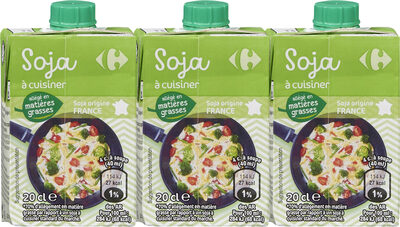Soja Cuisine - Carrefour - 20 cl
This product page is not complete. You can help to complete it by editing it and adding more data from the photos we have, or by taking more photos using the app for Android or iPhone/iPad. Thank you!
×
Some of the data for this product has been provided directly by the manufacturer Carrefour.
Barra-kodea: 3560070906208 (EAN / EAN-13)
Izen arrunta: Préparation culinaire à base de soja, allégée en matières grasses*, stérilisée UHT. *70% d'allègement en matière grasse par rapport à un soja à cuisiner standard du marché.
Kopurua: 20 cl
Ontziratzea: Tetra Pak, en:Brick, en:Cardboard, Tetra Brik Aseptic
Markak: Carrefour
Kategoriak: en:Plant-based foods and beverages, en:Plant-based foods, en:Plant-based creams, en:Plant-based creams for cooking, en:Soy-based creams for cooking
Etiketak, ziurtagiriak, sariak:
en:Low or no fat, Low fat, en:Reduced fat, fr:Soja Français, en:FSC, en:FSC Mix, en:Green Dot, en:Made in France, Triman


Origin of the product and/or its ingredients: Ce produit est fabriqué en France à partir de soja origine France.
Producer: Fabriqué en France par EMB 45273 pour Interdis.
Traceability code: EMB 45273 - Saint-Denis-de-l'Hôtel (Loiret, France)
Dendak: Carrefour, carrefour.fr
Matching with your preferences
Ingurumena
Carbon footprint
Ontziratzea
Transportation
Other information
Other information: Ces 3 briques ne peuvent être vendues séparément. 20cle + % AR Picto "Allégé en matières grasses*" Soja origine FRANCE *70% d'allègement en matière grasse par rapport à un soja à cuisiner standard du marché.
Preparation: Bien agiter avant utilisation.
Conservation conditions: À consommer de préférence avant le / N° de lot : voir sur le dessus de la brique. Avant ouverture : à conserver à température ambiante dans un endroit propre et sec à l'abri de la chaleur et de la lumière. Après ouverture : à conserver au réfrigérateur et à consommer dans les 5 jours.
Customer service: Interdis - TSA 91431 - 91343 MASSY Cedex - France
Report a problem
Datuen iturria
Product added on by kiliweb
Last edit of product page on by moon-rabbit.
Produktuaren orria -gatik editatua carrefour, date-limite-app, driveoff, ecoscore-impact-estimator, openfoodfacts-contributors, org-carrefour, packbot, quechoisir, roboto-app, spotter, tacite, teolemon, vaiton, yuka.WHBBeUd2d1RsT2NYb3ZFWndqSG85ZEpUeDZHQ1ptQzlEdThnSVE9PQ, yuka.WWJ3dVNwb29qS01TZzhRVjhVN1oyTUpSL0s3MVVIS2JOOW93SUE9PQ.










